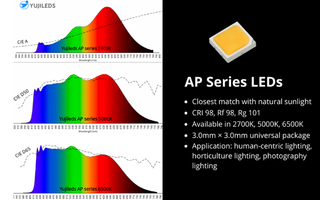I don't think it proves anything. Did they all measure the change in PAR with the different light? I'd happily wager that if two lights are PAR matched with differing spectrums, you won't notice a jot of difference in aquarium plant growth once the plants are adapted in the context of a home aquarium. As I said before, there are far too many other factors that will have a far greater influence on growth.
Well, if you look at Terrestrial plants like Cannabis(what most of these lights are used for) there is definitely growth differences between different lights(even with matched PPFD). I don't know much about it but, the lights are constantly evolving with new types of emitters, UV, IR, etc and massive improvement has been made since the dawn of LED Grow lights. I don't see why aquatic plants would be any different but, I'm not a scientist to know for sure. Maybe Diana Walstad or the like can chime in on this.
Which two then if not ADA or Chihiros? I like it that you are getting your teeth into it, but you need to reserve judgement until you've seen a proper RGB light over your tank. I've got around 10 different aquarium lights in my search for the best colour rendition, and one yet (the DIY Sunlike strips) yet to try.
Nicrew RGB-W 24/7 and a Hygger. Yes, in house trail would be best but, I don't have thousands of dollars to waste, especially on poorly designed lights with ridiculous spectrums and hugely inflated price tags. I suspect they would just be even more exaggerated then my Nicrew which is the best off name aquarium light available in Amazon from my research. The main reason for this whole discussion is helping me pick a light for my new 90. I am trying to use a combination of others first hand experience and knowledge with my own knowledge of lighting mixed with experiments of actual aquatic plants. Honestly, I really don't care that much and might just cave and get a AI Prime FW or Chihiros but, I am a bit obsessive with getting the best I can for the money I want to spend and the inflated prices for poor spectrums has me obsessin lol. I'm not buying until black Friday as my new tank doesn't get here until the start of November so, I have time to kill learning and experimenting so to speak.
Yes, I can agree with that to an extent, and has been my only complaint of these lights, but it still looks miles better than any white LED based light I've tried to date,
I don't doubt that but, that may be because very few if any quality aquarium lights exist. That's why I am looking at other options. I would gladly pay $1000US for a light like the Fluval 3.0 with a world class spectrum and emitter selection. Unfortunately that appears to not exist... This may push me to building my own quantum board out of some of the emitters I listed above but, I have too much on my plate to get into that right now.
and you can't say:. . . if you haven't even seen one over your own tank? How can you say they rub you up the wrong way, and have such a strong opinion when you've never even tried one at home?
There are several videos on YouTube and forums comparing these lights side by side on the same screen. It isn't hard to see the differences and compare the similar ones(or same exact light) to the way mine looks in house. There are also written and video commentaries from people who have owned the same or similar light to mine and upgraded to a Chihiros or the like and describe the differences, pros, & cons. I admit it m
ight not be as good as an in the house trail but, it is plenty good enough to see the differences imo. It doesn't always take first hand experience nowadays to know if something is right for you in my experience(the internet and high quality displays and testing equipment have helped this a lot).  www.waveformlighting.com
Not defending pricing just clarifying.
www.waveformlighting.com
Not defending pricing just clarifying.














